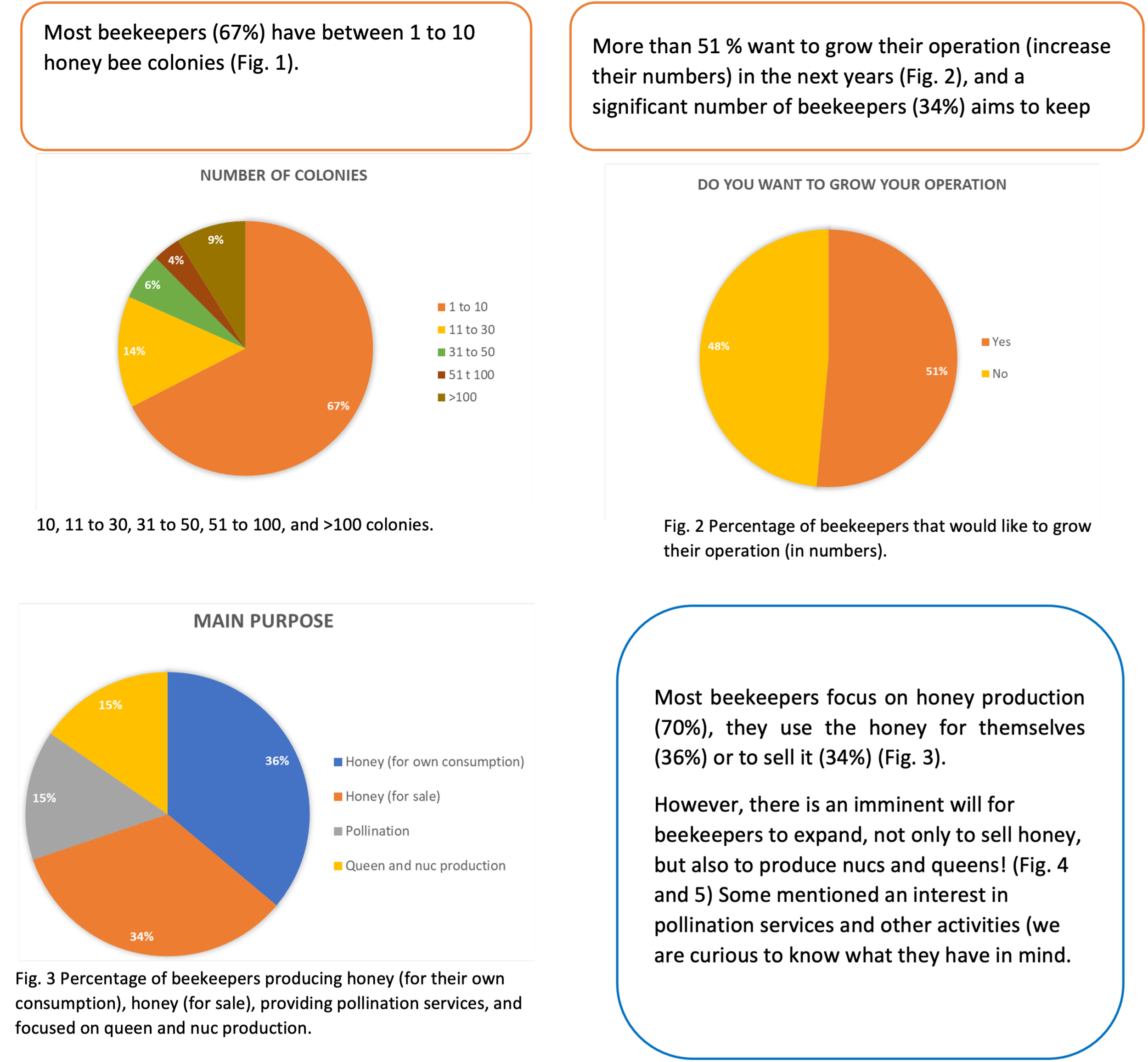Beekeeping Survey
download survey here
Results, Graphs & information on BC Honeybee Producers
Original Article published in BeesCene, Spring 2022
THE SURVEY
BC-TTP sent a surveyon November 2021 to all the members of British Columbia HoneyProducers Association (BCHPA).We had a great response from beekeepers and beekeepers’ clubs; we had more than 170 participants! The graph below shows the number of participants from each region.
Survey graph of participants by region
The survey helped the team identify priorities for 2022 and future years. Also, we got to know the beekeeping community better.
Here is what we found:
OUR 2022 PROJECTS
BC-TTP is planning a number of projects for 2022. The proj- ects are based on the challenges that beekeeping faces in BC and are focused on:
Integrated Pest Management (IPM)
Best Management Practices (BMP)
Sustainable Beekeeping
Selection and Breeding
Supporting local food production
Climate changeactions for agriculture and beekeeping
Varroa destructor parasitism was identified as the main challenge for beekeepers in BC, and it is the main cause of overwinter colony mortality in Canada (Currie et al., 2010). Therefore, one of our main projects for 2022 will focus on the fundamental component of IPM to control varroa mite levels: the varroa economicthreshold (ET). ET is the percentage of mites in a honey bee colony that causes economic damage (Brazmanet al., 2015).Knowing the varroaET is important, as it will determine the beekeeper’s actions to control the mite, like treating with organic or synthetic acaricides, or applying cultural methods to control mite levels (Pernal and Clay, 2013).
So far, the ET for varroa has been calculated for parts of North America, including eastern Canada, but has not been estimated for BC (Delaplane and Hood, 1999; Currie and Gatien, 2006; Guzman-Novoa et al., 2010). Also, changing environmental patterns and new viral variants linked to varroa parasitism could be influencing the ET for varroa (Sorker et al., 2021). The information generated in this project will be used in future studies, such as evaluating the efficacy of varroa treatments.
The project will need the participation of beekeepers across the province - it will be a Citizen Science study to gather in- formation from participating beekeepers on varroamite levels in the spring and fall, and on honey bee health parameters (colony strength, honey yield and overwinter success). Also, we will be collecting varroa mites on-siteto identify and quantify viruses. Here is more information on how to participate:
2022 Citizen Science Study to determine varroa ET in BC When? March 31, 2022 to March 31, 2023
Who? Beekeepers in British Columbia with at least 1 honey bee colony
How? I’m a beekeeper and I want to participate!
1. Send us an email to confirm your participation (info@ttp-bchpa.ca).
You will receive an invitation to join a webinar or watch a short video. The webinar/video will explain the importance of the project,the significance of your participation, how and when to fill the online form to collect data.
Optional:
Share your experience monitoring for varroa on Instagram (tag @bc-ttp and use the #BCTTPvarroa).
Join us at the BCHPA – Semi-Annual Educational days to know more about the project.
Share this information with other beekeepers, local clubs, and associations.
Check for updates in BeeScene, Instagram (@bc-ttp) and our website (http://ttp-bchpa.ca).
Send us your feedback with suggestions and comments (info@ttp-bchpa.ca).
We would like to thank all the beekeepers for the warm welcome of the BC-TTP, we are looking forward to working with you this coming season.
Acknowledgments: We gratefully acknowledge the financial support of the Province of British Columbia through the Ministry of Agriculture, Food and Fisheries.
Thanks to our collaborators: BCHPA executive and the British Columbia Bee Breeders' Association. Also, to our collaborators Dr. Leonard Foster, University of British Columbia; Dr. Marta Guarna, Agri-Food Canada; Dr. Olav Rueppell,University of Alberta;Dr. Rob Currie,University of Manitoba; Dr. Ernesto Guzman-Novoa, University of Guelph.
References
Barzman, M., Bàrberi, P., Birch, A.N.E.,Boonekamp, P., Dachbrodt- Saaydeh, S., Graf, B., Hommel, B., Jensen, J.E., Kiss, J., Kudsk, P., & Lamichhane, J.R. (2015). Eight principles of Integrated Pest Management. Agronomy for Sustainable Development, 35(4), 1199- 1215.
Currie, R. W. (2008). Economic threshold for Varroa on the Canadian Prairies. CanadianAssociation of Professional Apiculturists (CAPA) http://capabeesorg/content/uploads/2013/02/varroathresholdpdf.
Currie, R. W., Pernal, S. F., & Guzmán-Novoa, E. (2010). Honey bee colony losses in Canada. Journal of Apicultural Research, 49(1), 104-106.
Delaplane, K. S., & Hood, W. M. (1999). Economic threshold for Varroa jacobsoni Oud. in the southeastern USA. Apidologie, 30(5), 383-395.
Guzman-Novoa, E., Eccles,L., Calvete, Y., Mcgowan, J., Kelly,
P. G., & Correa-Benítez, A. (2010). Varroa destructor is the main culprit for the deathand reduced populations of overwintered honey bee (Apis mellifera) coloniesin Ontario, Canada.Apidologie, 41(4), 443-450.
Pernal, S. F., &Clay, H. (2013).Honey bee diseases and pests, 3rd Edition. Canadian Association of Professional Apiculturists, Beaverlodge, AB, Canada 68 pp.



